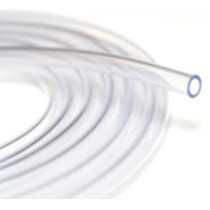Silicone is used in a variety of medical instruments and equipment which must be sterilized before use. Three main methods of sterilization can be considered: steam sterilization (autoclave), irradiation and ethylene oxide.
Steam Sterilization by Autoclave
Steam sterilization is typically carried out in an autoclave at 121°c (250°F) for 15 minutes, although other conditions are often used (Rogers, W., 2005). Silicone tubing may start to become gummy after having being steam sterilized several times and should then be replaced.
Irradiation:
Gamma Iradiation
Gamma irradiation is widely used for sterilization of silicone tubing. However, some changes are produced in the silicone, principally an increase in cross-linking, causing an increased hardness and shape memory (Rogers, W., 2005). The latter effect may make kinking of tubing more likely. The tensile elongation of platinum and peroxide cured silicones has been shown to decrease after gamma sterilization, while the tensile strength of platinum cured silicone remains nearly the same.
Electron Beam Irradiation
Electron Beam Irradiation is an alternative to gamma rays. The physical effects are similar, but somewhat less, to those found with gamma irradiation. Again greater degradation was noted with peroxide-cured silicone than with platinum-cured silicone (Gautriaud, E.).
Ethylene Oxide
Ethylene oxide (EO) is a very effective sterilizing method for most silicone materials (Rogers, W., 2005). The ethylene oxide is adsorbed by the silicone and must be removed by post-cycle aeration before the equipment is used. Appropriate testing is required to ensure that removal has occurred. A study (McGunnigle, R.G., 1975) showed that silicone tubing adsorbed about 85% less ethylene oxide than PVC tubing or polyester / polyurethane tubing. Also, desorption of the ethylene oxide was much faster for the silicone tubing than for the other two polymers. Ethylene oxide sterilization was found to have no significant adverse effects on platinum or peroxide cured silicone (Gautriaud, E.), so it is recommended in most cases for these materials. Since ethylene oxide is a toxic, carcinogenic gas, appropriate safety measures should always be in place.
Other Methods
Liquid sterilizing chemicals such as glutaraldehyde are sometime used. It is not clear if these are suitable in general for silicone medical equipment. Also, ozone is a highly toxic gas that can be used for silicone sterilization, but it can be less penetrating than ethylene oxide, only sterilizing surfaces.
Conclusions
Ethylene oxide is widely recommended to sterilize platinum and peroxide cured silicone. Irradiation or steam are also commonly used, but these methods should be considered on a case by case basis in order to not risk compromising critical material properties which ensure capabilities such as critical dosing in peristaltic pumps. Platinum-cured silicone is widely preferred to peroxide cured silicone where purity is a concern. However, peroxide cured silicones tend to have longer life in certain peristaltic pump applications. From the most exacting critical dosing to not so critical applications there are several types of silicones availabe to meet your specific needs. Contact your TBL Plastics representative for tailored recommendations about your process and technical information about our platinum cured silicone tubing or platinum cured silicone gaskets.
References
McGunnigle, R.G. et al (1975), “Residual ethylene oxide: levels in medical grade tubing and effects in an in-vitro biologic system”, Journal of Biomedical Materials Research, 9 (3), p.273-283. Palsule, A.S., Clarson,
S.J. & Widehouse C.W., (2008), “Gamma Irradiation of Silicones”, Journal of Inorganic and Organometallic Polymers and Materials, 18 (2), p.207-221. Rogers, W. (2005), Sterilisation of Polymer Healthcare Products, Shrewsbury: Rapra Technology.
Gautriad, E. et al. “Effect of Sterilization on the Mechanical Properties of Silicone Rubbers”

